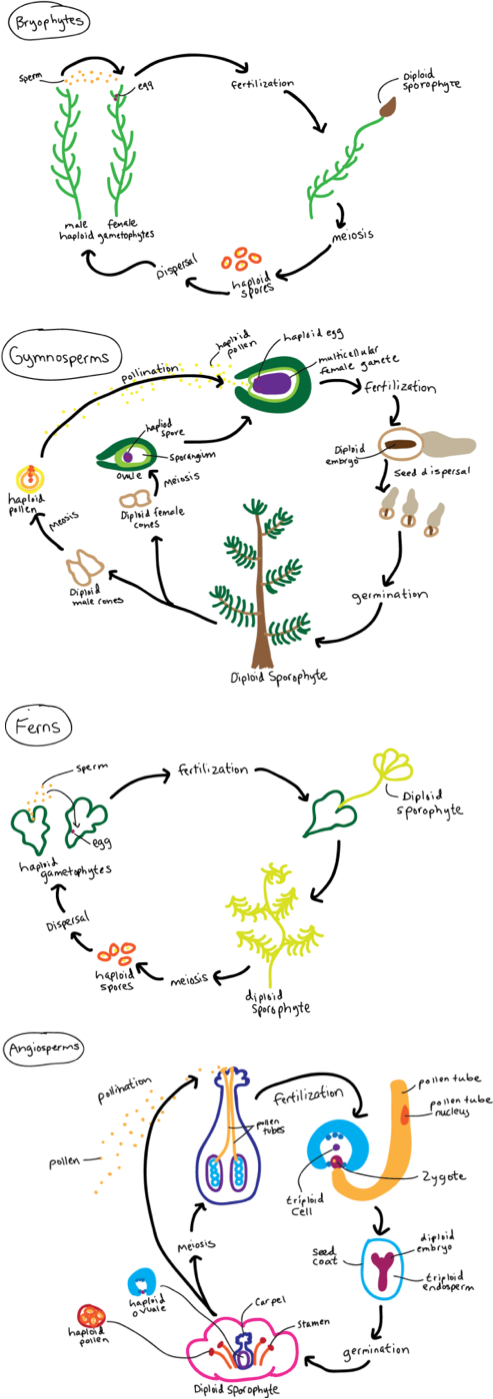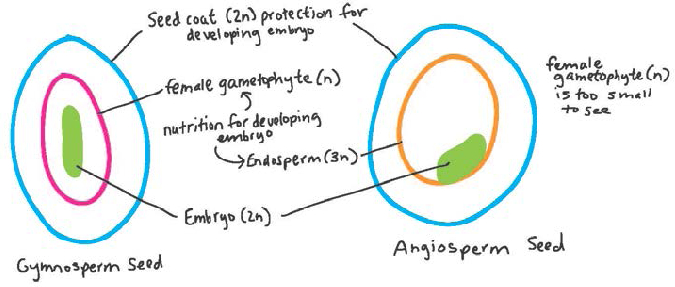Chapter 30 Summary
Core Concepts Summary
30.1 Alternation of generations evolved in plants by the addition of a diploid sporophyte generation that allows plants to disperse spores through the air.
The life cycle of the algal sister groups of land plants has one multicellular haploid generation. page 620
The life cycle of land plants is characterized by an alternation of haploid and diploid generations, one generation specialized for fertilization and the other for dispersal. page 621
Gametes are haploid cells produced by mitosis from cells in the multicellular haploid generation, which is referred to as the gametophyte generation. page 622
Spores are haploid cells produced by meiosis from the multicellular diploid generation, which is referred to as the sporophyte generation. page 622
Bryophytes have a free-
In spore-
Bryophytes and spore-
30.2 Pollen allows the male gametophyte to be transported through the air, while resources stored in seeds support the growth and development of the embryo.
Pollen is the male gametophyte that develops within the spore wall, and so can be transported through the air. page 625
The female gametophyte of seed plants is retained and nourished by the sporophyte. The female gametophyte, together with the surrounding layers of protective tissues, is called an ovule. Ovules, when fertilized, develop into seeds. page 625
Pollination is the transport of pollen to the ovule, where fertilization takes place. page 625
Seeds contain the diploid embryo, a seed coat, and, in gymnosperms, nourishment in the form of the female gametophyte. page 625
The pollen and ovules of gymnosperms are produced in separate structures, whereas the pollen and ovules of angiosperms often form in one structure, the flower. page 625
A trend in the evolution of plants is the progressive reduction in size and independence of the gametophyte and the increasing role of the sporophyte. page 627
30.3 Angiosperms (flowering plants) attract and reward animal pollinators, and they provide resources for seeds only after fertilization.
Flowers consist of four whorls of organs: ovule-
Many flowers attract animals because they provide a reward, such as food, shelter, or chemicals. Animals, in turn, transfer pollen. page 631
Many flowering plants have genetic and structural mechanisms to prevent self-
Double fertilization, which is unique to angiosperms, is the formation of a diploid zygote and triploid endosperm. The endosperm nourishes the embryo that develops from the zygote. page 635
The fertilization of an ovule triggers the development of the ovary wall into a fruit, a structure that enhances seed dispersal. page 636
30.4 Many plants also reproduce asexually.
Asexual reproduction produces new individuals without the need for uniting gametes. Dispersal of offspring, however, remains important. page 638
Apomixis is the formation of seeds from diploid cells, in the absence of fertilization. Seeds formed by apomixis are thus genetically identical to the parent plant. page 638
Vegetative reproduction can occur when a plant spreads horizontally and develops new upright shoots. page 638
Self-Assessment
Explain how the evolution of alternation of generations is an adaptation for reproduction on land.
Self-Assessment 1 Answer
Alternation of generations is the basic plant life cycle in which a haploid gametophyte stage and a diploid sporophyte stage follow one after the other. Alternation of generations has allowed plants to thrive on land because the haploid spores produced by the sporophyte can disperse over a large distance without the need for water.
Diagram the relationship between the sporophyte and gametophyte generations in bryophytes, ferns, gymnosperms, and angiosperms. Show the relative sizes and physical interactions (if any) of the two generations.
Self-Assessment 2 Answer

Explain how the organs in the different whorls of angiosperm flowers interact to promote fertilization.
Self-Assessment 3 Answer
The four whorls develop into carpels, stamens, petals, and sepals. A stamen has a structure called an anther that contains several sporangia in which pollen is produced. Once the anther splits open and exposes the pollen, the pollen can then be carried by animals or the wind to the sticky stigma of the carpels. Here, the pollen germinates and extends its pollen tube down through the style to reach the ovule in the ovary of the carpel.
The often colorful petals attract pollinators. The sepals do not play a direct role in fertilization; they protect the flower during its development.
Contrast the investments that angiosperms and gymnosperms make and the structures that they produce to enhance pollination.
Self-Assessment 4 Answer
Gymnosperm pollen and ovules are produced in separate structures, and pollen is carried to the female structure by the wind. Angiosperms often produce pollen and ovules in one structure, the flower. Some angiosperms take advantage of the wind to disperse their pollen, but more common is the use of animal pollinators.
Because the sites of pollen and ovule formation are near each other in a flower, a pollinator can deliver pollen to one plant and take up pollen to carry to another plant in a single visit. Pollen is captured on the sticky or feathery stigma at the top of the ovary-
containing carpel. Many angiosperms invest in rewards like nectar or attractants such as scent to lure pollinators. Diagram the structure of a mature angiosperm and a mature gymnosperm seed, indicating the ploidy (1n, 2n, 3n) of each tissue and its role in seed development and germination.
Self-Assessment 5 Answer

Describe two ways that plants can reproduce asexually and explain how each of these help to disperse offspring.
Self-Assessment 6 Answer
Plants are able to reproduce asexually by apomixis (formation of seeds without fertilization) and by vegetative reproduction (when a plant spreads horizontally and develops new upright shoots). Seeds formed by apomixis spread just like seeds produced sexually. Vegetative reproduction allows new shoots to spread, and sometimes break off, far from the parent plant.